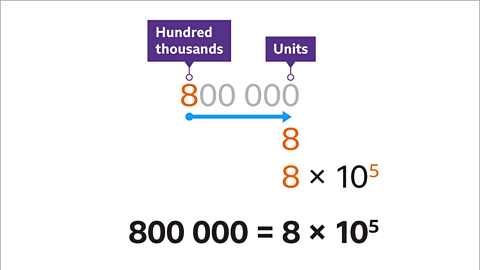Before reading this guide, it may be helpful to read the guide from Module 3 (M3) on equations.
Direct proportion
There is a direct proportion between two values when one is a multiple of the other. For example, \(1\text{cm} = 10\text{mm}.\) To convert \(\text{cm}\) to \(\text{mm}\), the multiplier is always 10.
Direct proportion is used to calculate the cost of petrol or exchange rates of foreign money.
The symbol for direct proportion is \(\propto\).
The statement âT is directly proportional to râ can be written using the proportionality symbol:
- \(T \propto r\)
This means that \(T = kr\).
\(k\) is a constant called the constant of proportionality.
There will be information in the question that will enable you to calculate the value of \(k\) and set up an equation.
There are four steps to do this:
- write the proportional relationship
- convert to an equation using a constant of proportionality
- use given information to find the constant of proportionality
- substitute the constant of proportionality into the equation
Example
The value \(e\) is directly proportional to \(p\). When \(e = 20\), \(p = 10\). Find an equation relating \(e\) and \(p\).
\(e \propto p\)
\(e = kp\)
\(20 = 10k\) so \(k = 20 \div 10 = 2\)
\(e = 2p\)
This equation can now be used to calculate other values of \(e\) and \(p\).
For example, if \(p = 6\) then \(e = 2 \times 6 = 12\).
In generalâŠ
- Write down how the variables are connected, using the proportion sign \(\propto\)
- Rewrite using \(k\) and an equal sign (\(=\))
- Substitute the values given for the two variables into this equation
- Solve to find a value for \(k\)
- Rewrite the equation using this value for \(k\)
- Use the equation as a formula to find any unknown values
Examples
Question
\(Q\) is proportional to \(p\). When \(p = 5\), \(Q = 20\).
Write and equation relating \(Q\) and \(p\) and use it to find the value of \(Q\) when \(p = 1.2\).
Solution
- Write down how the variables are connected, using the proportion sign \(\propto\)
\(Q\) is proportional to \(p\)
\(Q \propto p\)
- Rewrite using \(k\) and an equal sign (\(=\))
\(Q = kp\)
- Substitute the values given for the two variables into this equation
When \(p = 5\), \(Q = 20\), so \(20 = 5p\)
- Solve to find a value for \(k\)
\(k = 4\)
- Rewrite the equation, using this value for \(k\)
Equation is \(Q = 4p\)
- Use this formula to find any unknown values
When \(p = 1.2\), \(Q = 4(1.2)\)
\(= 4.8\)
Answer
\(Q = 4.8\)
Question
The value \(V\) (in \(\pounds\)) of a precious gem varies as the square of its weight \(w\) (in grams).
If a gem weighing \(0.8 \text{grams}\) is worth \(\pounds2000\),
- Find V in terms of w;
- How much will a gem weighing \(0.5\text{grams}\) be worth? Give your answer to the nearest \(\pounds\).
Solution
- Write down how the variables are connected, using the proportion sign \(\propto\)
\(V\) varies as the square of \(w\)
This is a different way to say '\(V\) is proportional to the square of \(w\)'.
Therefore, \(V \propto w^{2}\)
Make sure you square \(w\) and not \(V\)!
- Rewrite using \(k\) and an equal sign (\(=\))
\(V = kw^{2}\)
- Substitute the values given for the two variables into this equation
When \(w = 0.8\), \(V = 2000\), so \(2000 = (0.8)^{2}k\)
- Solve to find a value for \(k\)
\(\frac{2000}{0.8^{2}} = k\)
\(k = 3125\)
- Rewrite the equation using this value for \(k\)
\(V = 3125w^{2}\)
- Use this formula to find any unknown values
Find \(V\) when \(w = 0.5\)
\(V = 3125(0.5)^{2}\)
\(V = \pounds 781\) (nearest \(\pounds\))
Answer
\(\pounds 781\)
Question
\(z\) is proportional to the square root of \(y\). When \(y = 1.96\), \(z = 84\).
- Find a formula connecting \(z\) and \(y\).
- Find the value of \(y\) when \(z = 222\).
Solution
\(z\) is proportional to the square root of \(y\)
\(z \propto \sqrt{y}\)
A common error here is to write \(y^{2}\) instead of \(\sqrt{y}\).
\(z = k\sqrt{y}\)
\(y = 1.96 z = 84 \longrightarrow 84 = k\sqrt{1.96}\)
\(84 = 1.4k\)
\(k = 60\)
\(z = 60 \sqrt{y}\)
\(z = 222 y = ? \longrightarrow 222 = 60\sqrt{y}\)
\(\frac{222}{60} = \sqrt{y}\)
\(3.7 = \sqrt{y}\)
\(y = 3.7^{2} = 13.69\)
Answer
\(y = 13.69\)
Questions on this topic are often set in real-world situations, usually with scientific terms.
You do not need to understand the science behind the question â just pick out the variables, and find the connecting equation as in the examples above.
Test yourself
More on M7: Algebra
Find out more by working through a topic
- count4 of 4
